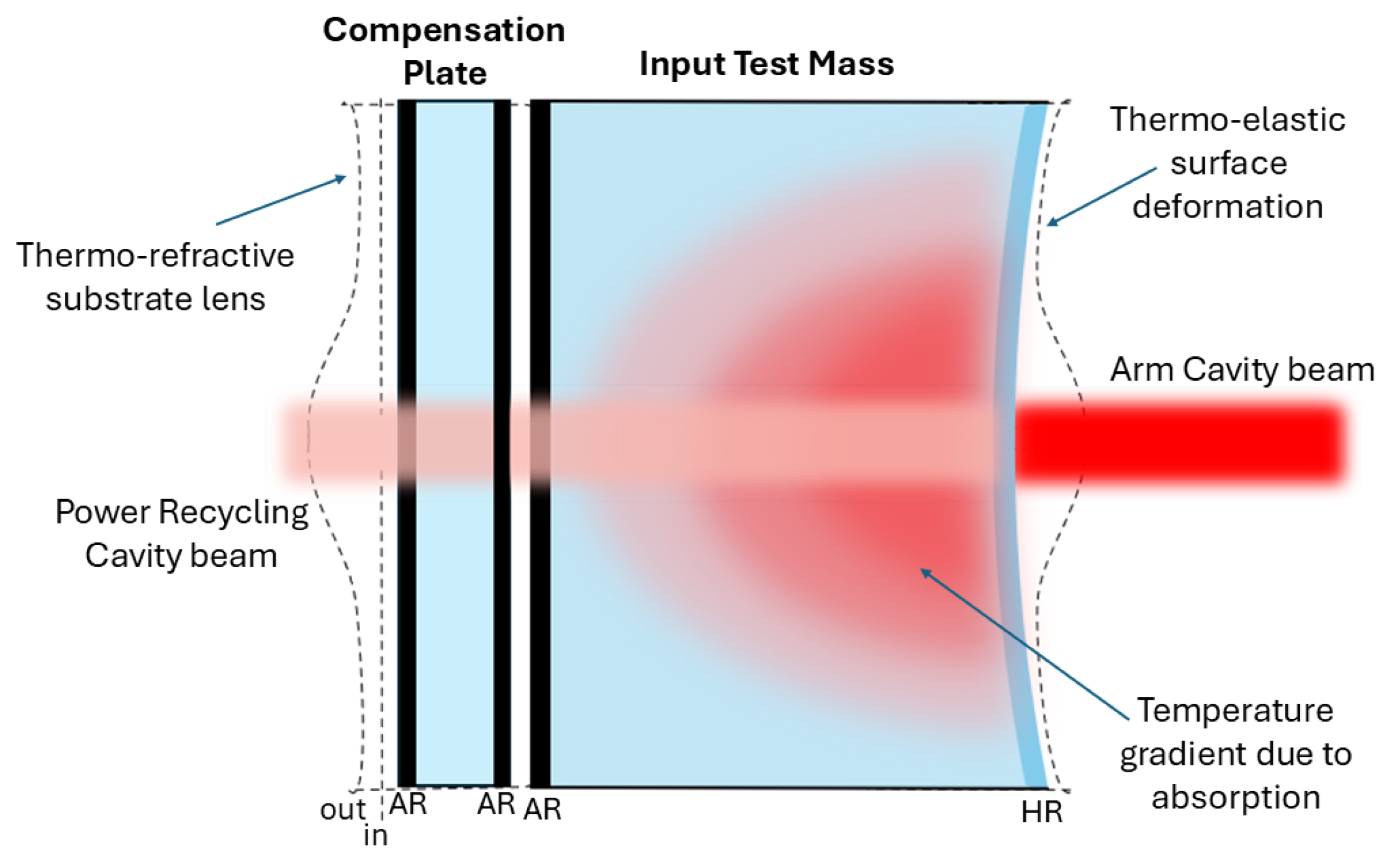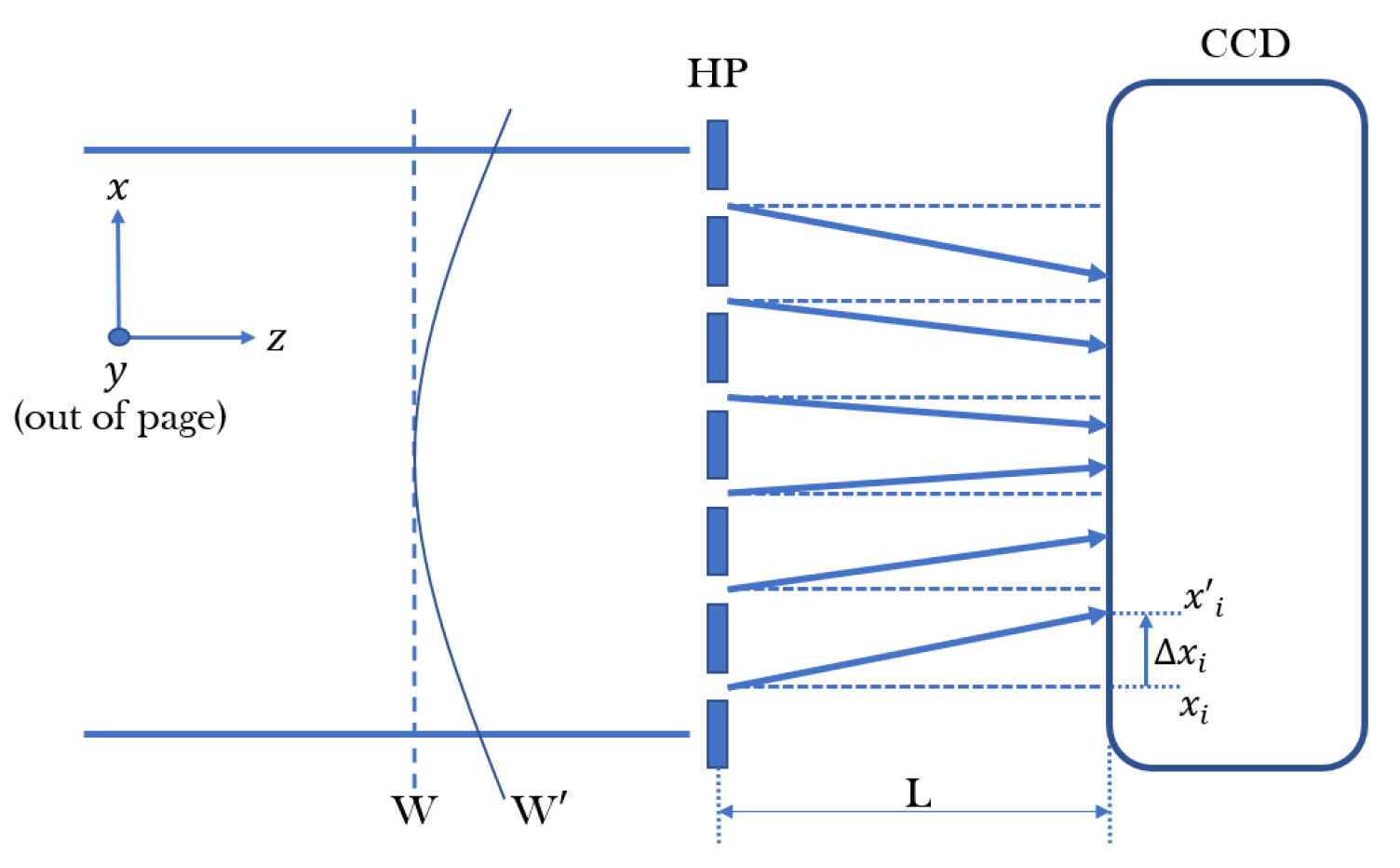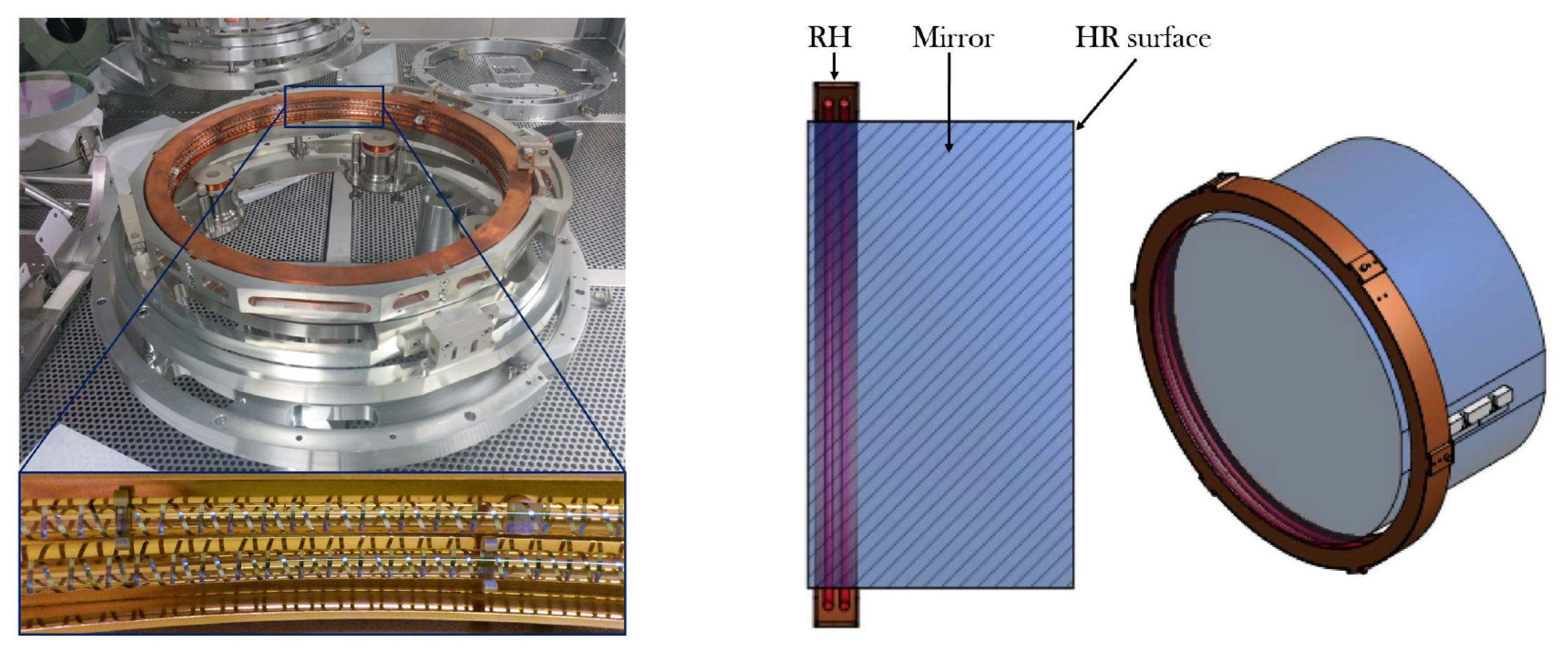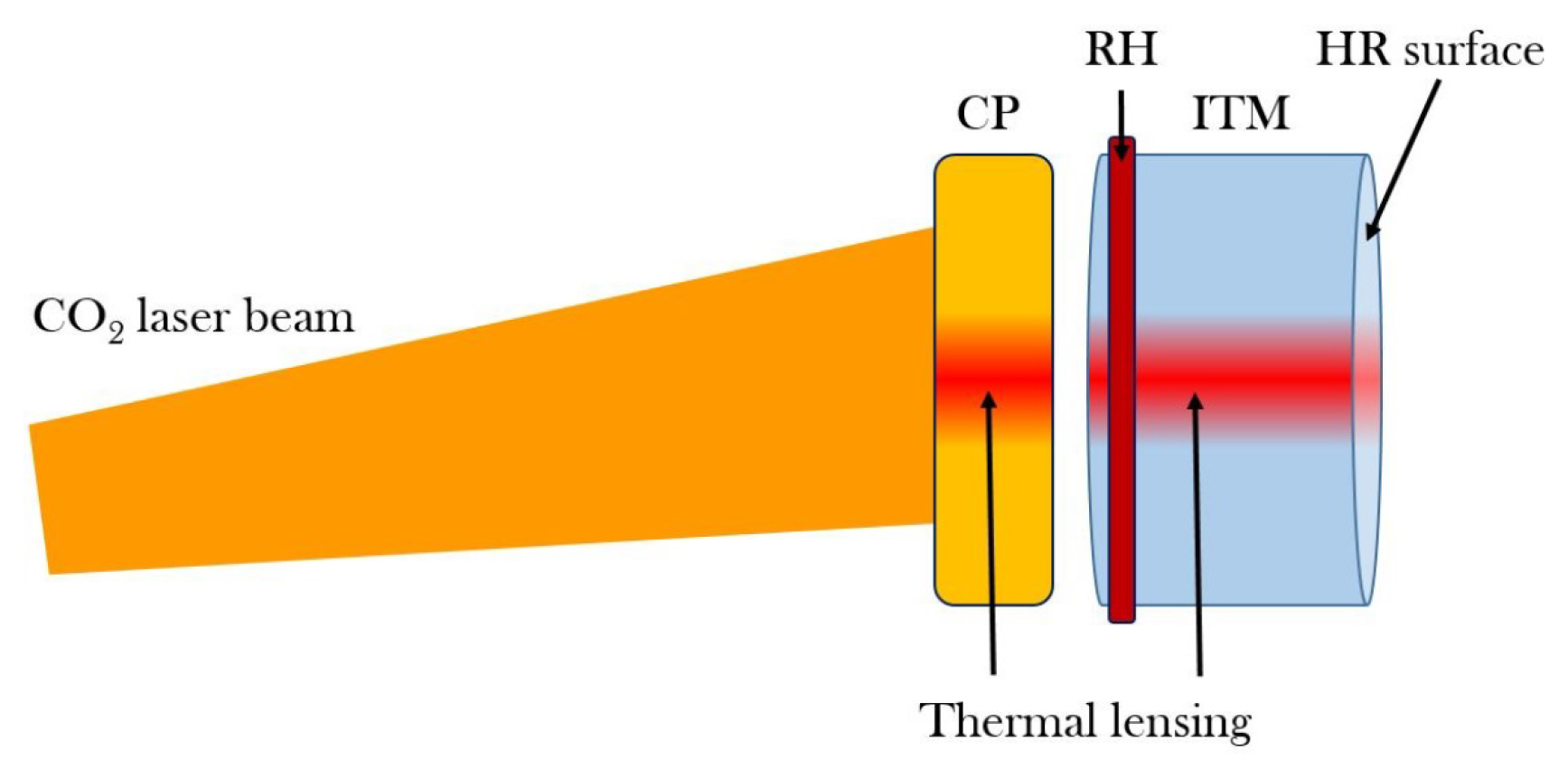Adaptive Optics for Aberration Control in Einstein Telescope
Abstract
1. Introduction
2. Core Optics for Third-Generation GW Detectors
2.1. Current Mirror Technologies
2.2. Challenges and Requirements for ET
3. Wavefront Distortions and Thermal Effects
3.1. Wavefront Distortions and Their Impact on the Interferometer Performance
3.2. Sources of WD and Thermal Effects
4. Design and Operation of a Thermal Compensation System
4.1. Requirements
- Actuation range. The actuators must handle the largest expected WD——with additional capacity to accommodate variations over time—at least by a factor of two.
- Actuation precision. Actuators must achieve sufficient resolution to prevent introducing new distortions that exceed allowable SNR losses
- Sensor range and precision. The sensor must be able to detect—while the detector still operates—the maximum expected residual distortion. Regarding its precision, it is usually required to be good enough such that random error in any measurement is less than one order of magnitude of the root mean square (RMS) tolerable WD .
- Bandwidth. The actuator must be able to properly compensate for any thermal change to keep within the maximum acceptable value. The bandwidth is computed from the thermal time constant of the effect to be compensated for. For static WDs, a DC-only control is usually required.
- Noise. Both sensors and actuators can inject noise at all frequencies—including in the sensing bandwidth of the detector, in which it could even limit and dominate the sensitivity in a specific frequency range. Therefore, the injected noise of the actuators and their couplings with the interferometer must be properly computed and considered in the design phase.
4.2. Sensors
4.2.1. Direct Sensing: Hartmann Wavefront Sensor
4.2.2. Indirect Sensing: Phase Camera
4.3. Actuators
4.3.1. Ring Heaters
4.3.2. CO2 Lasers Projector
5. Future Prospects for Thermal Effects Mitigation
6. Conclusions
Author Contributions
Funding
Institutional Review Board Statement
Informed Consent Statement
Data Availability Statement
Conflicts of Interest
Abbreviations
| CCD | Charge-Coupled Device |
| CH | Central Heating |
| CO | Core Optics |
| CP | Compensation Plate |
| CTN | Coating Thermal Noise |
| DAS | Double Axicon System |
| DM | Deformable Mirror |
| ET | Einstein Telescope |
| ET-HF | Einstein Telescope High-Frequency |
| ET-LF | Einstein Telescope Low-Frequency |
| ETM | End Test Mass |
| GW | Gravitational Wave |
| HOM | Higher Order Mode |
| HP | Hartmann Plate |
| HWS | Hartmann Wavefront Sensor |
| ITM | Input Test Mass |
| KAGRA | Kamioka Gravitational Wave Detector |
| LMA | Laboratoire des Matériaux Avancés |
| PC | Phase Camera |
| RH | Ring Heater |
| RMS | Root Mean Square |
| RoC | Radius of Curvature |
| SLED | Superluminescent Light Emitting Diode |
| SNR | Signal-to-Noise Ratio |
| TCS | Thermal Compensation System |
| TM | Test Mass |
| WD | Wavefront Distortion |
References
- Abbott, B.P. et al. [The LIGO Scientific Collaboration] Advanced LIGO. Class. Quantum Gravity 2015, 32, 074001. [Google Scholar] [CrossRef]
- Acernese, F.; Agathos, M.; Agatsuma, K.; Aisa, D.; Allemandou, N.; Allocca, A.; Amarni, J.; Astone, P.; Balestri, G.; Ballardin, G.; et al. Advanced Virgo: A second-generation interferometric gravitational wave detector. Class. Quantum Gravity 2014, 32, 024001. [Google Scholar] [CrossRef]
- Abbott, B.P. et al. [LIGO Scientific Collaboration and Virgo Collaboration] Observation of Gravitational Waves from a Binary Black Hole Merger. Phys. Rev. Lett. 2016, 116, 061102. [Google Scholar] [CrossRef] [PubMed]
- Abbott, B.P. et al. [LIGO Scientific Collaboration and Virgo Collaboration] GWTC-1: A Gravitational-Wave Transient Catalog of Compact Binary Mergers Observed by LIGO and Virgo during the First and Second Observing Runs. Phys. Rev. X 2019, 9, 031040. [Google Scholar] [CrossRef]
- Abbott, B.P. et al. [LIGO Scientific Collaboration and Virgo Collaboration] GWTC-2: Compact Binary Coalescences Observed by LIGO and Virgo During the First Half of the Third Observing Run. Phys. Rev. X 2021, 11, 021053. [Google Scholar] [CrossRef]
- Abbott, R. et al. [LIGO Scientific Collaboration] GWTC-2.1: Deep Extended Catalog of Compact Binary Coalescences Observed by LIGO and Virgo During the First Half of the Third Observing Run. arXiv 2021. [Google Scholar] [CrossRef]
- Abbott, R. et al. [LIGO Scientific Collaboration, Virgo Collaboration, and KAGRA Collaboration] GWTC-3: Compact Binary Coalescences Observed by LIGO and Virgo During the Second Part of the Third Observing Run. arXiv 2021. [Google Scholar] [CrossRef]
- Nitz, A.H.; Kumar, S.; Wang, Y.F.; Kastha, S.; Wu, S.; Schäfer, M.; Dhurkunde, R.; Capano, C.D. 4-OGC: Catalog of Gravitational Waves from Compact Binary Mergers. Astrophys. J. 2023, 946, 59. [Google Scholar] [CrossRef]
- Zhang, T.; Danilishin, S. Conceptual Design and Noise Budget of Einstein Telescope (ET Sensitivity Curve Update). Et Internal Note et-0007b-23. 2023. Available online: https://apps.et-gw.eu/tds/?r=18177 (accessed on 1 December 2024).
- Abernathy, M.; Acernese, F.; Ajith, P.; Allen, B.; Amaro Seoane, P.; Andersson, N.; Aoudia, S.; Astone, P.; Krishnan, B.; Barack, L.; et al. Einstein Gravitational Wave Telescope Conceptual Design Study. Technical Report, ET. ET-0106C-10. 2011. Available online: http://www.et-gw.eu/etdsdocument (accessed on 1 December 2024).
- The VIRGO Collaboration. The VIRGO large mirrors: A challenge for low loss coatings. Class. Quantum Gravity 2004, 21, S935–S945. [Google Scholar] [CrossRef]
- Penn, S.D.; Sneddon, P.H.; Armandula, H.; Betzwieser, J.C.; Cagnoli, G.; Camp, J.; Crooks, D.R.M.; Fejer, M.M.; Gretarsson, A.M.; Harry, G.M.; et al. Mechanical loss in tantala/silica dielectric mirror coatings. Class. Quantum Gravity 2003, 20, 2917–2928. [Google Scholar] [CrossRef]
- Crooks, D.R.M.; Cagnoli, G.; Fejer, M.M.; Gretarsson, A.; Harry, G.; Hough, J.; Nakagawa, N.; Penn, S.; Route, R.; Rowan, S.; et al. Experimental measurements of coating mechanical loss factors. Class. Quantum Gravity 2004, 21, S1059–S1065. [Google Scholar] [CrossRef][Green Version]
- Flaminio, R.; Franc, J.; Michel, C.; Morgado, N.; Pinard, L.; Sassolas, B. A study of coating mechanical and optical losses in view of reducing mirror thermal noise in gravitational wave detectors. Class. Quantum Gravity 2010, 27, 084030. [Google Scholar] [CrossRef]
- Pinard, L.; Michel, C.; Sassolas, B.; Balzarini, L.; Degallaix, J.; Dolique, V.; Flaminio, R.; Forest, D.; Granata, M.; Lagrange, B.; et al. Mirrors used in the LIGO interferometers for first detection of gravitational waves. Appl. Opt. 2017, 56, C11–C15. [Google Scholar] [CrossRef] [PubMed]
- Cole, G.D.; Groblacher, S.; Gugler, K.; Gigan, S.; Aspelmeyer, M. Monocrystalline AlxGa1-xAs heterostructures for high-reflectivity high-Q micromechanical resonators in the megahertz regime. Appl. Phys. Lett. 2008, 92, 261108. [Google Scholar] [CrossRef]
- Beausoleil, R.G.; Gustafson, E.K.; Fejer, M.M.; D’Ambrosio, E.; Kells, W.; Camp, J. Model of thermal wave-front distortion in interferometric gravitational-wave detectors. I. Thermal focusing. J. Opt. Soc. Am. B 2003, 20, 1247–1268. [Google Scholar] [CrossRef]
- Saulson, P. Advanced Interferometric Gravitational-Wave Detectors; WSP: Singapore, 2019. [Google Scholar] [CrossRef]
- Ryan Christopher, L. Active Wavefront Correction in Laser Interferometric Gravitational Wave Detectors. Ph.D. Thesis, MIT, Cambridge, MA, USA, 2003. [Google Scholar]
- Nadji, S.; Wittel, H.; Mukund, N.; Lough, J.; Affeldt, C.; Bergamin, F.; Brinkmann, M.; Kringel, V.; Lück, H.; Weinert, M.; et al. GEO 600 beam splitter thermal compensation system: New design and commissioning. Class. Quantum Gravity 2024, 42, 025009. [Google Scholar] [CrossRef]
- Siegman, A.E. Lasers; University Science Books: Sausalito, CA, USA, 1986. [Google Scholar]
- Brooks, A. Hartmann Wavefront Sensors for Advanced Gravitational Wave Interferometers. Ph.D. Thesis, University of Adelaide, Adelaide, Australia, 2007. [Google Scholar]
- Aiello, L.; Palma, P.P.; Lorenzini, M.; Cesarini, E.; Cifaldi, M.; Fronzo, C.D.; Lumaca, D.; Minenkov, Y.; Nardecchia, I.; Rocchi, A.; et al. Thermal defocus-free Hartmann Wavefront Sensors for monitoring aberrations in Advanced Virgo. Class. Quantum Gravity 2024, 41, 125001. [Google Scholar] [CrossRef]
- Nardecchia, I. Detecting Gravitational Waves with Advanced Virgo. Galaxies 2022, 10, 28. [Google Scholar] [CrossRef]
- van der Schaaf, L.; Agatsuma, K.; van Beuzekom, M.; Gebyehu, M.; van den Brand, J. Advanced Virgo phase cameras. J. Phys. Conf. Ser. 2016, 718, 072008. [Google Scholar] [CrossRef]
- van der Schaaf, L. The Phase Cameras of Advanced Virgo. Ph.D. Thesis, Vrije Universiteit Amsterdam, Amsterdam, The Netherlands, 2020. [Google Scholar]
- Aiello, L.; Cesarini, E.; Fafone, V.; Lorenzini, M.; Minenkov, Y.; Nardecchia, I.; Rocchi, A.; Sequino, V. Thermal compensation system in advanced and third generation gravitational wave interferometric detectors. J. Phys. Conf. Ser. 2019, 1226, 012019. [Google Scholar] [CrossRef]
- Nardecchia, I.; Minenkov, Y.; Lorenzini, M.; Aiello, L.; Cesarini, E.; Lumaca, D.; Malvezzi, V.; Paoletti, F.; Rocchi, A.; Fafone, V. Optimized radius of curvature tuning for the virgo core optics. Class. Quantum Gravity 2023, 40, 055004. [Google Scholar] [CrossRef]
- Aiello, L. Development of New Approaches for Optical Aberration Control in Gravitational Wave Interferometersl. Ph.D. Thesis, SISSA and GSSI, Physics Division, L’Aquila, Italy, 2019. Available online: https://iris.gssi.it/handle/20.500.12571/9702 (accessed on 1 December 2024).
- The Virgo Collaboration. Advanced Virgo Technical Design Report. Virgo Internal Note vir-0128a-12. 2012. Available online: https://tds.virgo-gw.eu/?content=3&r=9317 (accessed on 1 December 2024).
- Rocchi, A. Thermal Effects and Other Wavefront Aberrations in Recycling Cavities. In Advanced Interferometers and the Search for Gravitational Waves: Lectures from the First VESF School on Advanced Detectors for Gravitational Waves; Springer: Cham, Switzerland, 2014; pp. 251–274. [Google Scholar] [CrossRef]
- Cifaldi, M. Mitigation of Anomalous Absorption in the Virgo Core Optics. Ph.D. Thesis, Tor Vergata University of Rome, Department of Physics, Roma, Italy, 2023. [Google Scholar]
- Taranto, C. Upgraded Optical Aberration Correction Techniques for Advanced Virgo Plus: Commissioning toward O4 and Mitigation of Non-Axisymmetric Optical Defects. Ph.D. Thesis, Sapienza University of Rome, Tor Vergata University of Rome and National Institute of Astrophysics, Department of Physics, Roma, Italy, 2023. [Google Scholar]
- Cao, H.T.; Brooks, A.; Kuns, K.E.A. Post-05 thermal modeling A# TCS requirements status of HOM ring heater. In Proceedings of the LIGO-Virgo-KAGRA Biannual Conference, Toyama, Japan, 11–15 September 2023. Conference Presentation LIGO-G2300624. [Google Scholar]
- Hamedan, V.J.; Blair, C.; Liu, J.; Bossilkov, V.; Zhao, C.; Ju, L.; Blair, D.G. Preventing transient parametric instabilities in high power gravitational wave detectors using thermal transient compensation. Class. Quantum Gravity 2017, 34, 145014. [Google Scholar] [CrossRef]
- Hamedan, V.J.; Zhao, C.; Ju, L.; Blair, C.; Blair, D.G. Suppression of thermal transients in advanced LIGO interferometers using CO2 laser preheating. Class. Quantum Gravity 2018, 35, 115006. [Google Scholar] [CrossRef]
- Cifaldi, M.; Cesarini, E.; Fafone, V.; Lorenzini, M.; Lumaca, D.; Minenkov, Y.; Nardecchia, I.; Rocchi, A.; Taranto, C. Coping with anomalous power absorptions in the Advanced Virgo core optics. Nuovo Cim. C 2022, 45, 140. [Google Scholar] [CrossRef]






| Flatness | Thickness Uniformity | Absorption | Scattering |
|---|---|---|---|
| <0.5 nm RMS | 0.05% | <0.4 ppm | <10 ppm |
| (within ⊘ 150 mm) | (within ⊘ 150 mm) |
Disclaimer/Publisher’s Note: The statements, opinions and data contained in all publications are solely those of the individual author(s) and contributor(s) and not of MDPI and/or the editor(s). MDPI and/or the editor(s) disclaim responsibility for any injury to people or property resulting from any ideas, methods, instructions or products referred to in the content. |
© 2025 by the authors. Licensee MDPI, Basel, Switzerland. This article is an open access article distributed under the terms and conditions of the Creative Commons Attribution (CC BY) license (https://creativecommons.org/licenses/by/4.0/).
Share and Cite
Cifaldi, M.; Taranto, C.; Aiello, L.; Lumaca, D. Adaptive Optics for Aberration Control in Einstein Telescope. Galaxies 2025, 13, 18. https://doi.org/10.3390/galaxies13020018
Cifaldi M, Taranto C, Aiello L, Lumaca D. Adaptive Optics for Aberration Control in Einstein Telescope. Galaxies. 2025; 13(2):18. https://doi.org/10.3390/galaxies13020018
Chicago/Turabian StyleCifaldi, Maria, Claudia Taranto, Lorenzo Aiello, and Diana Lumaca. 2025. "Adaptive Optics for Aberration Control in Einstein Telescope" Galaxies 13, no. 2: 18. https://doi.org/10.3390/galaxies13020018
APA StyleCifaldi, M., Taranto, C., Aiello, L., & Lumaca, D. (2025). Adaptive Optics for Aberration Control in Einstein Telescope. Galaxies, 13(2), 18. https://doi.org/10.3390/galaxies13020018









